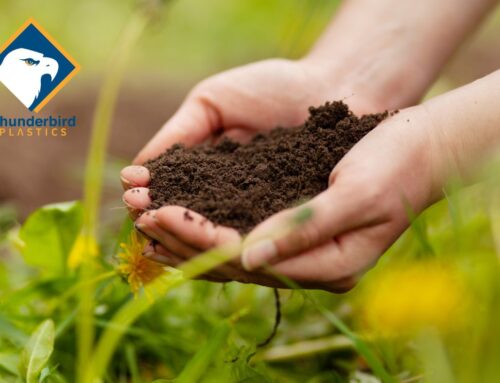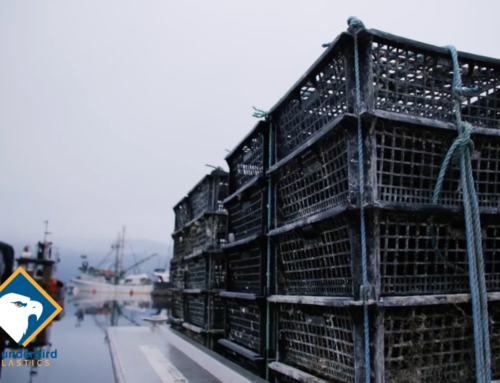What Is a Berry?
To understand what a berry is, it is important to distinguish between the botanical definition of a berry and the commonly accepted definition. Flowering plants have ovaries that develop into fruits that contain seeds after fertilization. In the botanical definition, a berry is a fruit with seeds that have developed from a single ovary of a single flower. It is fleshy throughout and therefore fully edible, unlike an apple or a peach with a core or pit. Many fruits commonly referred to as berries are not berries in the botanical sense because they are formed from multiple ovaries of a single flower [1].
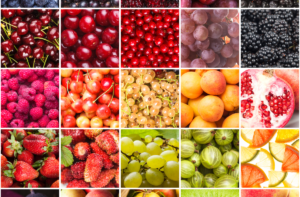
All of these are berries by the botanical definition.
For the purposes of this article, we will use the commonly used meaning of a berry. Regardless of the botanical definition, fruits that are commonly referred to as berries have many commonalities that are more relevant to farmers than the technicalities above.
Cultivation and Storage of Berries
While various berries will have different cultivation requirements, most berries must only be harvested when ripe [2]. These delicate fruits are also often hand-picked to avoid damage and must be cooled quickly after harvest to slow down their metabolic process. During transport to market, it is important to keep them cooled and in ventilated containers to avoid moisture.
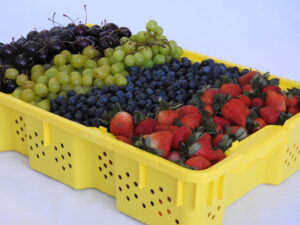
Our Thunderbird berry tray with dividers.
The product engineers here at Thunderbird Plastics understand the science of berries from cultivation, to harvest, to market – they are ideal for every step of the process. Features of our food-grade containers include ventilation, transparency for inspection, stackability, reusability, and as always, recyclability.
Strawberries: Cultivation, Harvest, and Storage
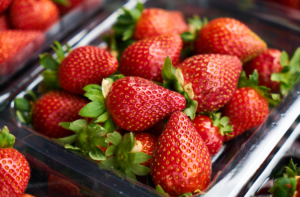
Strawberries can be grown in many areas in the world.
Strawberries grow best in full sun and in soil that is a balanced mixture of sand, silt, and clay with a pH of 5.5 to 6.5. This requirement allows them to grow in various global regions including North America, Europe, Asia, and Australia. Farmers often plant strawberries in raised beds and encourage the growth of long, thin stems called runners that extend from the main plant and produce additional plants along the surface of the soil. This reduces the need to plant new strawberry plants and use additional seeds [3]. When the strawberry is red and ripe, it can be harvested and should be cooled quickly and stored in breathable containers. Consumers at home should store their strawberries in their original packaging and only wash them right before eating to prevent moisture and mold growth.
Blueberries: Cultivation, Harvest, and Storage
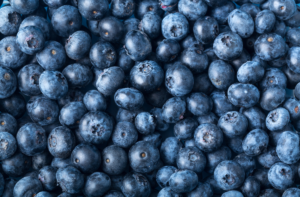
Blueberries – a delicious and nutritious snack.
Blueberry plants require periods of cold winter and warm growing seasons with soil that is well-drained and acidic with a pH of 4.5 to 4.8. The shallow root system requires a deep layer of mulch to keep moisture in the soil and to protect it from heat [4]. Blueberries are often harvested when they turn all turn a uniform blue color [5]. After harvest, they should be cooled immediately, stored in their original ventilated packaging, and only washed just before consumption.
Raspberries: Cultivation, Harvest, and Storage
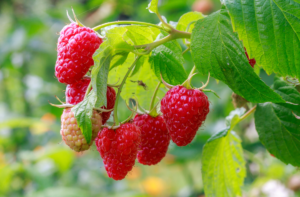
Raspberries ready to be harvested.
While wild raspberries can grow in a wide variety of conditions, cultivated raspberries produce the most fruit with a trellis supporting the canes and growing in soil rich with organic matter and a pH between 5.5 and 6.5. The raspberry plant’s roots are particularly sensitive to overly wet soil. The plant should be watered once a week and the soil around it must be able to drain properly. The raspberry is unique to other berries because it is structured from multiple small sacs containing a single seed. These sacs, or drupelets, are formed around a central core which remains on the plant when harvested, leaving a hollow fruit behind. Depending on the type of raspberry (everbearing vs. summer-bearing) there are different harvest times and yields. Everbearing raspberries can be harvested twice a year while summer-bearing varieties only provide one harvest per year [7]. The raspberry fruit does not ripen significantly once harvested and so it must be picked when ripe. This fact, paired with the fruit’s hollow structure, makes storage of the berry a delicate process. A shallow and well-ventilated container (like our shallow, flat berry tray) is required to keep the berries in a single layer to prevent crushing. To extend shelf life, raspberries should be immediately cooled and only washed immediately before consumption to prevent unnecessary moisture during storage.
Other Lesser-Known Edible Berries Around the Globe
1. Mulberry Varieties
White Mulberry (Morus alba): Native to Asia, widely cultivated for its sweet berries.
Black Mulberry (Morus nigra): Native to western Asia, prized for its large, sweet berries.
Red Mulberry (Morus rubra): Native to North America, known for its juicy, flavorful berries.
2. Rubus Berries (Blackberries, Raspberries, and Hybrids)
Blackberry (Rubus fruticosus): Widely distributed in Europe and North America, known for its sweet-tart berries.
Dewberry (Rubus spp.): Several species in the Rubus genus, similar to blackberries but with a trailing growth habit.
Boysenberry (Rubus ursinus × idaeus): Hybrid of blackberry, raspberry, and loganberry, known for its large, sweet-tart berries.
Loganberry (Rubus × loganobaccus): Hybrid of raspberry and blackberry, known for its tart-sweet berries.
Tayberry (Rubus fruticosus × idaeus): Hybrid of raspberry and blackberry, known for its large, sweet-tart berries.
3. Cloudberry and Related
Cloudberry (Rubus chamaemorus): Native to Arctic and subarctic regions, known for its golden-yellow, tart berries.
Aqpik/Bakeapple (another name for cloudberry): Used in Canada and parts of northern North America.
4. Currants
Blackcurrant (Ribes nigrum): Known for its tart berries used in jams and desserts.
Redcurrant (Ribes rubrum): Native to western Europe, used in jams, jellies, and desserts.
Whitecurrant (Ribes rubrum): Cultivated variety of redcurrant with translucent white berries.
5. Bilberry and Variants
Bilberry (Vaccinium myrtillus): Native to Europe, known for its small, dark-blue berries similar to blueberries.
Fraughan/Whinberry/Whortleberry/Hurtleberry (other names for Bilberry): Common name for wild blueberries in parts of Europe and North America.
6. Unique Flavored and Specialty Berries
Açaí Berry (Euterpe oleracea): Native to South America, known for its antioxidant-rich berries used in smoothies and bowls.
Barberry (Berberis spp.): Various species with tart berries used in jams and sometimes dried as a spice.
Chuckleberry (a hybrid berry): Used in culinary applications for its unique flavor.
Cornelian Cherry (Cornus mas): Native to Europe and western Asia, known for its tart berries used in preserves and liqueurs.
Cranberry (Vaccinium macrocarpon): Native to North America, known for its tart berries used in juices and sauces.
Elderberry (Sambucus nigra): Native to Europe and North America, known for its small, dark berries used in wines, jams, and syrups.
Goji Berry (Gojiberry) (Lycium barbarum): Native to Asia, known for its small, red berries used in teas and health products.
Juneberry (Amelanchier spp.): Also known as Serviceberry, known for its sweet, blueberry-like berries.
Lingonberry (Vaccinium vitis-idaea): Native to northern regions, known for its tart berries used in jams and sauces.
Marasca Cherry (Prunus cerasus): Known for its bitter cherries used in maraschino liqueur.
Myrtleberry (various species in the Myrtus genus): Known for small berries used in jams and traditional dishes.
Pineberry (a variety of strawberry): White strawberry with a pineapple-like flavor, cultivated for its unique appearance and taste.
Salmonberry (Rubus spectabilis): Native to the Pacific Northwest, known for its sweet, salmon-colored berries.
Whinberry (another name for Bilberry or Whortleberry): Used in various culinary applications in certain regions.
The Proper Container For the Longest Berry Shelf-Life & Storage
For optimal freshness and quality from harvest to market, it is important to use proper containers.
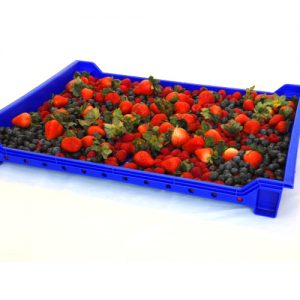
Our shallow, flat berry tray ensures that berries are stored in one layer to avoid crushing.
It is increasingly common for berry farmers to use harvesting machines for efficiency and cost-effectiveness.
Harvesting blueberries by hand requires up to 1200 hours of labor per hectare annually [6]. However, if the harvesting containers and machines are of lower quality, there are risks to quality and shelf life.
If the machine has surfaces that are not smooth, and the berries hit these rough surfaces after falling, the berries will experience significant bruising. Thunderbird Plastic’s containers provide optional smooth walls and various degrees of perforation to provide the best fit for both machine harvesting or hand-picking.
Ahead of the berry industry increasingly moving towards mechanized harvesting machinery, the engineers at Thunderbird Plastics have developed a berry tray that can be used as both a tray for a mechanized harvester and a handheld tray. Thunderbird Plastics is also able to create new bespoke designs for our clients to fit any type of use or machinery.
Thunderbird Plastics: The Right Containers for Berries
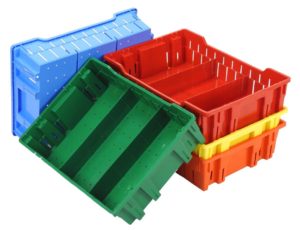
Our Nest & Stack Berry Tray with Dividers
The Nest & Stack Berry Tray with dividers features internal dividers to prevent clustering and compressing the fruit. When empty, the tray is nestable, and when it is full of berries, the tray can be rotated 180 degrees to stack securely while protecting the berries. Several versions of the Nest & Stack Berry Tray come with varying amounts of perforations.
The Science of Storing Berries
Thunderbird Plastic’s engineers understand the scientific principles followed by farmers and distributors to ensure the highest quality berries reach the market. Each berry requires specific growing, harvesting, and storage conditions. At Thunderbird Plastics, there is a diverse range of containers for each berry from the shallow & flat berry tray to the agricultural containers with various degrees of perforations. Each Thunderbird product is durable, intelligently designed, and able to accommodate varying storage temperatures without losing structural integrity. As with all of our food storage containers, rest assured that the materials we use are food-grade and recyclable at the end of their useful life.
Make Thunderbird Plastics your quality-preserving berry industry partner by contacting 888.77T.BIRD or info@ThunderbirdPlastics.com for a quote today!
References:
Joseph, S. V., Edirisinghe, I., & Burton-Freeman, B. M. (2014). Berries: Anti-inflammatory Effects in Humans. Journal of Agricultural and Food Chemistry, 62(18), 3886-3903. DOI: 10.1021/jf4044056.
Howard, L. R., Prior, R. L., Liyanage, R., & Lay, J. O. (2012). Processing and Storage Effect on Berry Polyphenols: Challenges and Implications for Bioactive Properties. Journal of Agricultural and Food Chemistry, 60(27), 6678–6693. DOI: 10.1021/jf2046575.
Oğuz, İ., et al. (2023). Strawberry Cultivation Techniques. In Recent Studies on Strawberries. IntechOpen. DOI: 10.5772/intechopen.104611.
Prodorutti, D., et al. (2007). Highbush blueberry: Cultivation, protection, breeding and biotechnology. The European Journal of Plant Science and Biotechnology, 1(1), 44-56.
Cvetković, M., Kočić, M., Dabić Zagorac, D., Ćirić, I., Natić, M., Hajder, Đ., Životić, A., & Fotirić Akšić, M. (2022). When Is the Right Moment to Pick Blueberries? Variation in Agronomic and Chemical Properties of Blueberry (Vaccinium corymbosum) Cultivars at Different Harvest Times. Metabolites, 12(9), 798. DOI: 10.3390/metabo12090798.
Takeda, Fumiomi, Wei Q. Yang, Changying Li, Andris Freivalds, Kiseok Sung, Rui Xu, Bo Hu, Jeffrey Williamson, and Steven Sargent. 2017. “Applying New Technologies to Transform Blueberry Harvesting” Agronomy 7, no. 2: 33. https://doi.org/10.3390/agronomy7020033
Hoover, E., et al. (1988). Vegetative and reproductive yield components of primocane-fruiting red raspberries. Journal of the American Society for Horticultural Science, 113(6), 824-826.


